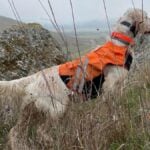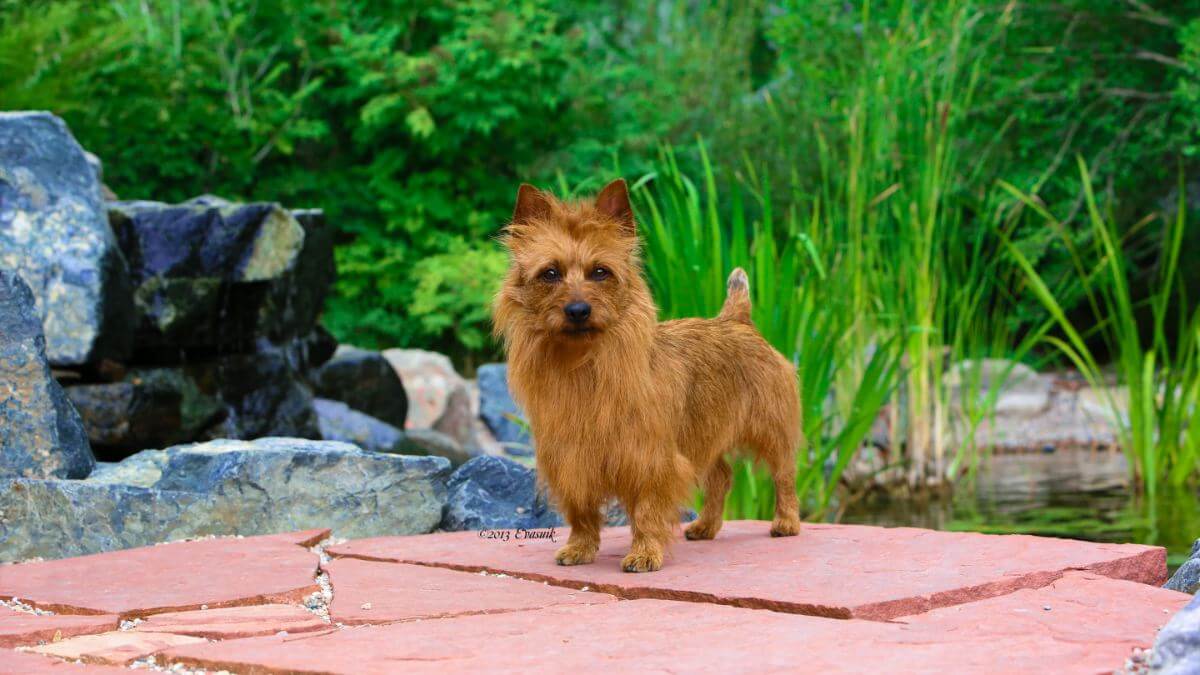
Home » Grooming the Australian Terrier – A View Over Time

This article was originally published in Showsight Magazine, July 2017 issue.
Roller coaster toplines and crooked fronts were evident when I first started showing Aussies in the 70s. Dogs being shown then ranged widely in size, substance, and type. Coats were just tidied up, and the condition of the coat itself varied.
While the coat should be a double coat and harsh in texture, coats ranged from soft to hard. The softer coats tended to be longer—4 to 6 inches (most often 6 inches)—than the 2 ½ inches called for in the Standard, and the hard coats were shorter as furnishings were more difficult to grow.
The grooming of the heads also varied. Some dogs had more hair on the muzzle, similar to the way a silky is shown today; the cheeks were kept full, and the ruff and topknot were not blended into the body coat.
This is not to imply that there were not lovely examples of the breed being shown, only that in the ring, the dogs ranged widely in type and grooming. Although an Aussie could place in the Group, it was not happening often.
With the coming of the 80s, more dogs were being shown, and grooming changed from tidying up to a more groomed coat as the dogs in competition were being exhibited more often.
I remember a conversation I had with Barbara Deer, who came to me and said I was showing my special in a too-short coat (the dog was Marge Reignier’s Ch. Crestwood Crackerjack). I explained to her that because the dog was being shown two weekends a month, I was rolling his coat to keep it in prime condition and that if she was going to fault me for showing in 1 ½ – 2 inches of coat, she would also have to fault all the 6” soft coats, which were too long.
To my amazement (and hers, I think), she agreed with me, and we became friends. One of the things that had drawn me to the Aussies, other than the dogs themselves, was the people who owned them.
In my humble opinion, it is important to listen when someone long in the breed takes the time or makes the effort to offer advice.
After my conversation with Barbara Deer, I made a conscious effort to try to meet the Standard when presenting a dog in the ring. I was often asked to look at dogs both as show prospects and in regard to grooming.
Once at a National Specialty where I had a busy schedule, I remember being asked by Ida Ellen Weinstock to look at a dog, who had not placed in his class, to see what I thought of him.
It was not her dog, but she had liked him and thought he should have done better. After telling the owner of this nice dog that if she waited until I was done for the day, I would help her with some grooming, I continued to work.
The owner, to her credit, patiently waited until the end of a very long day. Then we discussed the grooming of the dog. I did some for her and then told her what she needed to do before showing the next day.
I felt very rewarded the next day when the dog (owner-handled) took Winners Dog. A good dog can be lost if his coat gives the illusion of a topline that isn’t level or that the front is winging out.
The grooming sessions at the ATCA National Specialty grew out of the requests of so many members asking for help. These sessions were set up so that members could learn by working on their own dogs, and the result was that dogs at the National were better prepared for the ring.
A comment made to me at this time was that it takes a brave person to help the competition. My answer to that is that you get back what you give to the sport. When it only becomes competition, and there is no joy in sharing or giving back, then something important has been lost.
The grooming sessions grew to include handling lessons as other members also started adding their expertise to the annual Education Day programs. ATCA members benefited from other members’ years of experience. Aussies were winning in the Groups and doing it more often.
The 90s for me started a new chapter as I began handling a red special, Ch. Regency Lord of Summerhill (owned by Ida Ellen Weinstock). He had a lovely coat that always had a layer beneath, and his coat was a clear red.
Once again, I was fortunate to be part of a winning team. He was a dog that moved wonderfully and was a joy in my house while he lived with me.
Although he was a tough dog in the ring, he loved my parents’ dog, Louie Emmet (a black dachshund mix who stayed the winters with me while they were in Florida). The two dogs shared a bed with us and were best buddies.
This dog was the first red Australian Terrier in the US to win an All Breed Best in Show. He had a long, strong muzzle and did not need a lot of hair on the muzzle or cheeks but needed to have his ruff and furnishings tidied.
Now, back to grooming:
I have found over the years that the hair at the elbows tends to wing out when a dog moves forward, and I take this excess hair off. I also look at the dog’s front coming at me and take the corners of the shelf off to bring the judge’s eye toward the center of the dog and not draw it away by an appearance of width.
To show rear extension, hair should be shaped to leave the hock joint clean of hair (each dog evaluated on its structure). Viewed from the rear, the hips should not bulge out.
Over the years, members have heard me mention “the Aussie glob” — that is, a bunch of hair on the underbelly that hangs down. When the dog is moving, it tends to drag the eye down with it. It disrupts the image of a clean underline.
Thus, the reminder to look at your dog from all sides, both on the table and when moving on the ground.
The length of the neck on a dog can be accentuated by shortening the hair on the neck to the base of the occiput. The hair on the sides of the neck is then kept shorter than the hair in the center.
This will accentuate a good neck and shoulder or give the illusion of the arch and length of neck the Standard requires.
The scruffy look of yesterday has been replaced by a more sculpted look today. But the presentation should always be to the Standard.